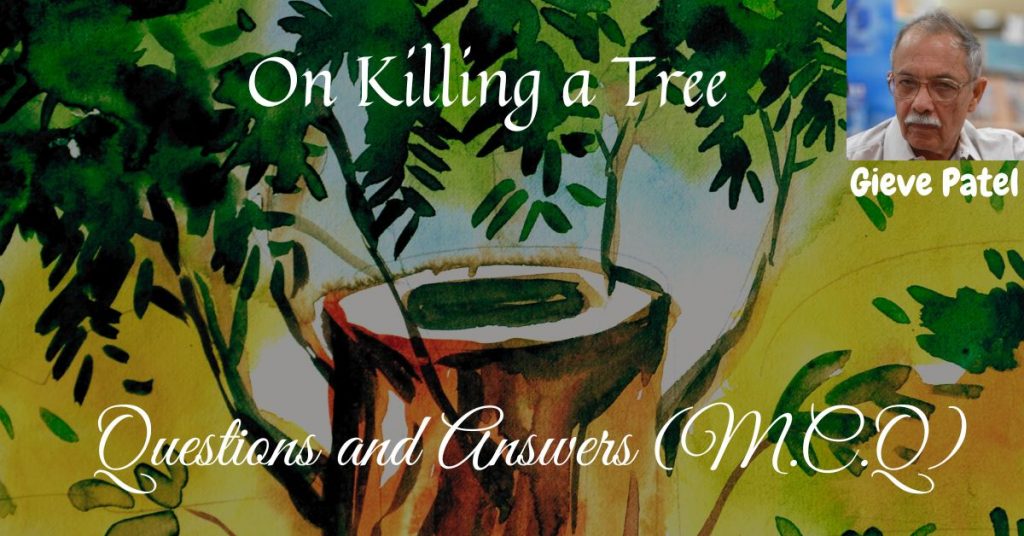
1. On killing a tree is written by –
a) Arthur Rimbaud b)William Shakespeare c)John Keats d) Gieve Patel
Ans. d) Gieve Patel
2. It takes much time to kill a tree. The statement indicates –
A) a sense of impatience that it takes such effort to kill a tree B) a sense of irony that it is not a simple task to kill a tree C) a sense of defeat that it takes time to kill a tree D) a sense of joy that the tree cannot be easily killed
Ans. B) a sense of irony that it is not a simple task to kill a tree
3. The poem ‘On Killing a Tree’ is based on the theme that –
A) adversity is a blessing in disguise B) in spite of all odds, life tries to recreate itself C) struggle is life D) it is useless to cry over spilt milk
Ans. B) in spite of all odds, life tries to recreate itself
4. “A simple jab of the knife” can’t do what? –
A) It cannot kill a tree B) It cannot hamper a tree’s growth C) It cannot hurt a tree D) It cannot stab a tree
Ans. A) It cannot kill a tree
5. The tree is too hard to be destroyed with –
A) sudden pull of the rope B) a simple blow of the knife C) the destruction of leaves and branches D) the severance of the bark
Ans. B) a simple blow of the knife
6. The tree has grown by feeding itself on the nutrition provided by –
A) the sun B)water C) air D)the earth
Ans. D)the earth
7. By consuming the nutrients of the earth, the tree has grown –
A) at a rapid rate B) very slowly C) slowly D) fast
Ans. C) slowly
8. The observation about the growth of the tree is –
A) the tree grows slowly B) the tree does not grow at all C) the tree grows steadily D) the tree grows rapidly
Ans. A) the tree grows slowly
9. The word, ‘crust’ here refers to –
A) the outer part of bread B) the earth’s solid exterior C) the bark of the tree D) the scaly covering on a skin
Ans. B) the earth’s solid exterior
10. A tree grows by absorbing –
A) sunlight B) water C)air D) all of the above
Ans. D) all of the above
11. The bark of the tree is described as ‘leprous hide’ because it is –
A) soft and smooth B) wounded by the knife C) rough and has marks D) glossy and shining [H.S. = 2016]
Ans. C) rough and has marks
12. The expression ‘leprous hide’ refers to –
A) the tree’s bark B) smooth skin C) the leper’s skin D) none of the above
Ans. A) the tree’s bark
13. The expression, ‘leprous hide’ is a fine example of –
A) irony B) simile C) metaphor D) assonance
Ans. C) metaphor
14. Leaves sprout out of the tree’s –
A) green twigs B) white root C) leprous hide D) dry stem
Ans. C) leprous hide
15. The poet uses the expression, ‘Sprouting leaves’ to suggest the idea of –
A) approaching death B) a vibrant life C) continuous life-cycle D) producing a new replica
Ans. D) producing a new replica
16. Hacking and chopping can cause a tree –
A) much pain B) little pain C) not so much pain D) pleasure
Ans. A) much pain
17. How does a tree overcome hacking and chopping? –
A) by producing small green stems close to the ground B) by sprouting small branches C) by expanding again to former size D) all the three
Ans. D) all the three
18. The purpose of killing the tree is not fulfilled in spite of –
A) inflicting pain B) chopping C) hacking D) all of the above
Ans. D) all of the above
19. The epithet, ‘hack and chop’ clearly reveals –
A) resilience of the tree B) a philosophy of violence C) greater violence against nature D) sympathy for the tree
Ans. C) greater violence against nature
20. The bark of the tree bleeds because of –
A) stabbing B) choking C) uprooting D) hacking and chopping
Ans. D) hacking and chopping
21. The figure of speech used in the expression, ‘Not so much pain will do it’ is –
A) hyperbole B) hyperbaton C) imagery D) personification
Ans. B) hyperbaton
22. The bark that bleeds –
A) heals itself B) becomes leprous C) dies of shock D) becomes dry
Ans. A) heals itself
23. The phrase, ‘bleeding bark’ brings before our eyes the condition of a –
A) dying branch B) growing new shoots C) severed bark D) withering tree-stump
Ans. C) severed bark
24. The literary device used in the phrase, ‘bleeding bark’ is –
A) alliteration B) personification C) allusion D)metaphor
Ans. A) alliteration
25. Curled green twigs rise from –
A) the chopped tree B) close to the ground C) the top of the tree D) uprooted tree
Ans. B) close to the ground
26. A twig is a –
A) sapling B) big branch C) tender shoot of a tree D) stem of the young tree
Ans. C) tender shoot of a tree
27. Miniature boughs will expand again to their former size if –
A) unchecked B) checked C) repeatedly chopped D) uprooted
Ans. A) unchecked
28. The growth of ‘miniature boughs’ is suggestive of the –
A) undying strength B) futile act of killing C) birthright of a tree D) lively attitude of the poet
Ans. A) undying strength
29. In order to kill a tree successfully, it is to be –
A) stabbed B) hacked C) uprooted D) chopped
Ans. C) uprooted
30. The root of the tree is –
A) green and dry B) white and wet C) green and wet D) white and dry
Ans. B) white and wet
31. The tree’s inner source of strength is its –
A) taproot C) bark C) root D) stem
Ans. C) root
32. The most sensitive part of the tree is its –
A) leaf B) bark C) root D) stem
Ans. C) root
33. The phrase ‘anchoring earth’ suggests that –
A) the roots of the tree cling to the earth B) the roots of the tree are drawing sap C) the earth holds the tree D) the tree is the anchor of the earth
Ans. A) the roots of the tree cling to the earth
34. The figure of speech used in the phrase, ‘anchoring earth’ is –
A)metaphor B) personification C) allusion D) simile
Ans. A)metaphor
35. The strength of the tree gets exposed when it is –
A) pulled out B) stabbed C) planted D) chopped and hacked
Ans. A) pulled out
36. What is formed in the earth when a tree is uprooted?
A) an earth-cave B) an anchor C) a pond D) a hollow space for a new tree
Ans. A) an earth-cave
37. The phrase ‘earth cave’ indicates –
A) the cave in which the tree was planted B) the hollow in which the tree grows C) the earth in which the tree is planted D) the gaping hole in the earth when the roots are pulled out
Ans. D) the gaping hole in the earth when the roots are pulled out
38. After uprooting, the tree is exposed –
A) for sprouting leaves B) for scorching and choking C) for preparation of food D) for revival
Ans. B) for scorching and choking
39. “And then it is done.”-Here ‘it’ refers to –
A) killing of a tree B) planting of a tree C) healing touch D) green twigs
Ans. A) killing of a tree
40. “But this alone won’t do it”-‘It’ refers to –
A) killing of a tree B) browning of roots c) growth of a tree D) sprouting of leaves
Ans. A) killing of a tree
41. That the tree is personified is suggested by the line –
A) So hack and chop B) But this alone won’t do it C)The bleeding bark will heal D)Will rise curled green twigs
Ans. C)The bleeding bark will heal
42. The ‘curled green twigs’ rise from –
A) the earth’s cave B) the uprooted tree C) close to the ground D) the rough bark [H.S. = 2018]
Ans. C) close to the ground
43. Green Twigs that rise from close to the ground are –
A) straight B) curled C) crooked D) crinkled [H.S. = 2019]
Ans. B) curled
44. In ‘Miniature boughs’, the word ‘boughs’ means –
A) shoots B) roots C) frost D) rain [H.S. = 2015]
Ans. A) shoots
45. What does the poet refer to as the ‘strength of the tree’? –
A) green twigs B) sprouting leaves C) miniature boughs D) life-supporting roots
Ans. D) life-supporting roots
46. What gets exposed as a result of uprooting? –
A) miniature boughs B) green twigs C) new leaves D) life-supporting roots
Ans. D) life-supporting roots
47. The root needs to be pulled out of the –
A) firm soil B) anchoring earth C) unground D) firm earth [H.S. = 2017]
Ans. B) anchoring earth
48. Why is the source white? –
A) because it absorbs sunlight B) because it has been painted white C) because it remains hidden inside the earth D) because it is full of phosphorus
Ans. C) because it remains hidden inside the earth
49. Why is ‘the source’ wet? –
A) because it is full of water and other nutrients B) because it is exposed to rain C) because it is in water D) because it reflects sunlight
Ans. A) because it is full of water and other nutrients
50. What does the poem ‘On Killing a Tree’ expose? –
A) man’s love for nature B) man’s cruelty towards nature C) man’s indifference to nature D) man’s endeavour to protect nature
Ans. B) man’s cruelty towards nature
51. In what form of verse is the poem, ‘On Killing a Tree’ written? –
A) blank verse B) free verse C) iambic pentameter D) rhyming couplet
Ans. B) free verse
52. What makes the poem ‘On Killing a Tree’ impressive? –
A) conversational tone and logical sequence B) brilliant image and personification C) ironical treatment of the theme D) all of these
Ans. D) all of these
53. In the poem the killing of a tree is described as –
A) a deliberate act B) an innocent act C) a healthy exercise D) a woodcutter’s job
Ans. A) a deliberate act
54. The poet seems to suggest that in order to kill a tree –
A) plucking out all the leaves will do the job B) some pain will do the job C) cutting the branches will do the job D) destruction of the roots will do the job [H.S. = 2020]
Ans. D) destruction of the roots will do the job
55.. Where does irony lie in the poem? –
A) that the killing is almost ceremonial B) that trees don’t die C) that nature is resilient D) that man is a killer
Ans. A) that the killing is almost ceremonial
Read more about:
∎ ‘On Killing a Tree’ by Gieve Patel, questions and answers(S.A.Q.), Class – 12, WBCHSE
∎ ‘On Killing a Tree’ by Gieve Patel – questions and answers(L.A.Q.), class – 12, WBCHSE
